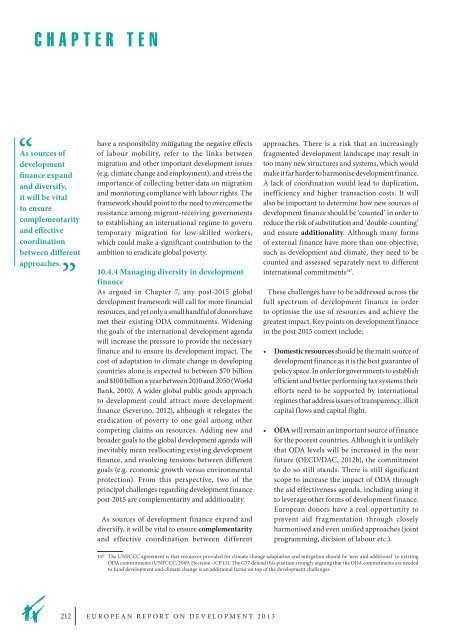Post 2015: Global Action for an Inclusive and Sustainable Future
Post 2015: Global Action for an Inclusive and Sustainable Future
Post 2015: Global Action for an Inclusive and Sustainable Future
Create successful ePaper yourself
Turn your PDF publications into a flip-book with our unique Google optimized e-Paper software.
CHApTER TEn<br />
As sources of<br />
development<br />
fin<strong>an</strong>ce exp<strong>an</strong>d<br />
<strong>an</strong>d diversify,<br />
it will be vital<br />
to ensure<br />
complementarity<br />
<strong>an</strong>d effective<br />
coordination<br />
between different<br />
approaches.<br />
212<br />
have a responsibility mitigating the negative effects<br />
of labour mobility, refer to the links between<br />
migration <strong>an</strong>d other import<strong>an</strong>t development issues<br />
(e.g. climate ch<strong>an</strong>ge <strong>an</strong>d employment), <strong>an</strong>d stress the<br />
import<strong>an</strong>ce of collecting better data on migration<br />
<strong>an</strong>d monitoring compli<strong>an</strong>ce with labour rights. the<br />
framework should point to the need to overcome the<br />
resist<strong>an</strong>ce among migr<strong>an</strong>t-receiving governments<br />
to establishing <strong>an</strong> international regime to govern<br />
temporary migration <strong>for</strong> low-skilled workers,<br />
which could make a signific<strong>an</strong>t contribution to the<br />
ambition to eradicate global poverty.<br />
10.4.4 M<strong>an</strong>aging diversity in development<br />
fin<strong>an</strong>ce<br />
as argued in chapter 7, <strong>an</strong>y post-<strong>2015</strong> global<br />
development framework will call <strong>for</strong> more fin<strong>an</strong>cial<br />
resources, <strong>an</strong>d yet only a small h<strong>an</strong>dful of donors have<br />
met their existing oDa commitments. Widening<br />
the goals of the international development agenda<br />
will increase the pressure to provide the necessary<br />
fin<strong>an</strong>ce <strong>an</strong>d to ensure its development impact. the<br />
cost of adaptation to climate ch<strong>an</strong>ge in developing<br />
countries alone is expected to between $70 billion<br />
<strong>an</strong>d $100 billion a year between 2010 <strong>an</strong>d 2050 (World<br />
b<strong>an</strong>k, 2010). a wider global public goods approach<br />
to development could attract more development<br />
fin<strong>an</strong>ce (Severino, 2012), although it relegates the<br />
eradication of poverty to one goal among other<br />
competing claims on resources. adding new <strong>an</strong>d<br />
broader goals to the global development agenda will<br />
inevitably me<strong>an</strong> reallocating existing development<br />
fin<strong>an</strong>ce, <strong>an</strong>d resolving tensions between different<br />
goals (e.g. economic growth versus environmental<br />
protection). From this perspective, two of the<br />
principal challenges regarding development fin<strong>an</strong>ce<br />
post-<strong>2015</strong> are complementarity <strong>an</strong>d additionality.<br />
as sources of development fin<strong>an</strong>ce exp<strong>an</strong>d <strong>an</strong>d<br />
diversify, it will be vital to ensure complementarity<br />
<strong>an</strong>d effective coordination between different<br />
EuropE<strong>an</strong> rEport on DEvElopmEnt 2013<br />
approaches. there is a risk that <strong>an</strong> increasingly<br />
fragmented development l<strong>an</strong>dscape may result in<br />
too m<strong>an</strong>y new structures <strong>an</strong>d systems, which would<br />
make it far harder to harmonise development fin<strong>an</strong>ce.<br />
a lack of coordination would lead to duplication,<br />
inefficiency <strong>an</strong>d higher tr<strong>an</strong>saction costs. It will<br />
also be import<strong>an</strong>t to determine how new sources of<br />
development fin<strong>an</strong>ce should be ‘counted’ in order to<br />
reduce the risk of substitution <strong>an</strong>d ‘double-counting’<br />
<strong>an</strong>d ensure additionality. although m<strong>an</strong>y <strong>for</strong>ms<br />
of external fin<strong>an</strong>ce have more th<strong>an</strong> one objective,<br />
such as development <strong>an</strong>d climate, they need to be<br />
counted <strong>an</strong>d assessed separately next to different<br />
international commitments 147 .<br />
these challenges have to be addressed across the<br />
full spectrum of development fin<strong>an</strong>ce in order<br />
to optimise the use of resources <strong>an</strong>d achieve the<br />
greatest impact. Key points on development fin<strong>an</strong>ce<br />
in the post-<strong>2015</strong> context include:<br />
• Domestic resources should be the main source of<br />
development fin<strong>an</strong>ce as it is the best guar<strong>an</strong>tee of<br />
policy space. In order <strong>for</strong> governments to establish<br />
efficient <strong>an</strong>d better per<strong>for</strong>ming tax systems their<br />
ef<strong>for</strong>ts need to be supported by international<br />
regimes that address issues of tr<strong>an</strong>sparency, illicit<br />
capital flows <strong>an</strong>d capital flight.<br />
• ODA will remain <strong>an</strong> import<strong>an</strong>t source of fin<strong>an</strong>ce<br />
<strong>for</strong> the poorest countries. although it is unlikely<br />
that oDa levels will be increased in the near<br />
future (oEcD/Dac, 2012b), the commitment<br />
to do so still st<strong>an</strong>ds. there is still signific<strong>an</strong>t<br />
scope to increase the impact of oDa through<br />
the aid effectiveness agenda, including using it<br />
to leverage other <strong>for</strong>ms of development fin<strong>an</strong>ce.<br />
Europe<strong>an</strong> donors have a real opportunity to<br />
prevent aid fragmentation through closely<br />
harmonised <strong>an</strong>d even unified approaches (joint<br />
programming, division of labour etc.).<br />
147 the unFccc agreement is that resources provided <strong>for</strong> climate ch<strong>an</strong>ge adaptation <strong>an</strong>d mitigation should be ‘new <strong>an</strong>d additional’ to existing<br />
oDa commitments (unFccc, 2009, Decision -/cp.15). the G77 defend this position strongly arguing that the oDa commitments are needed<br />
to fund development <strong>an</strong>d climate ch<strong>an</strong>ge is <strong>an</strong> additional factor on top of the development challenges.

















